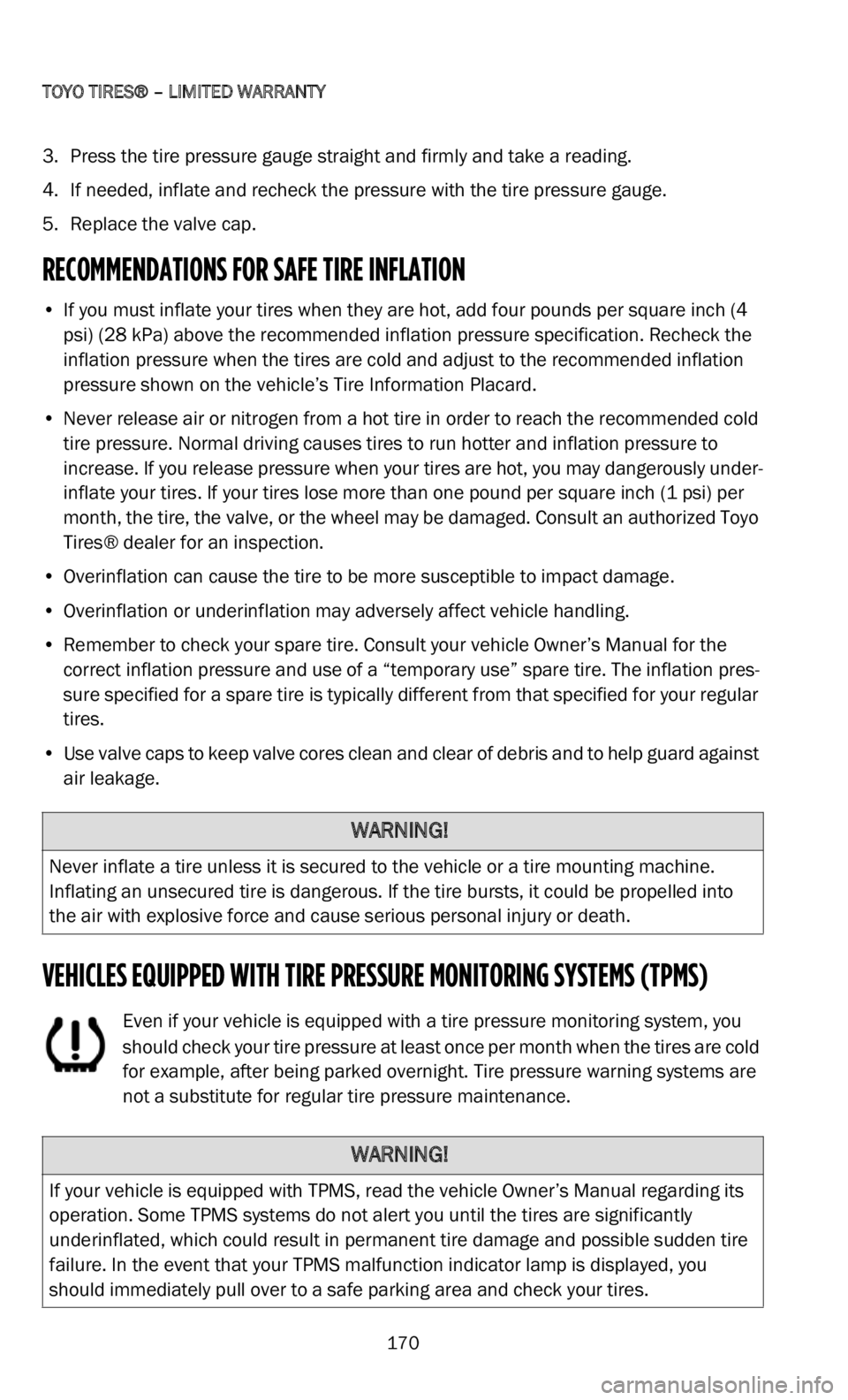TPMS DODGE DURANGO 2022 Vehicle Warranty
[x] Cancel search | Manufacturer: DODGE, Model Year: 2022, Model line: DURANGO, Model: DODGE DURANGO 2022Pages: 200, PDF Size: 6.72 MB
Page 99 of 200

GOODYEAR® DUNLOP® TIRES
98
DO CHECK YOUR TIRES FOR DAMAGE
Frequent (at least monthly) inspection of your tires for signs of damage and their general
condition is important for safety. If you have any questions, have your tire dealer inspect
them. Impacts, penetrations, cracks, knots, bulges or air loss always require tire removal
and expert inspection. Never perform a temporary repair or use an inner tube as a
substitute for a proper repair. Only qualified persons should repair tires.
PROPER TIRE REPAIR
Goodyear® does not warrant any inspection or repair process. The repair is entirely the
responsibility of the repairer and should be made in accordance with established Rubber
Manufacturers Association (RMA) procedures.
Tire Pressure Monitoring System (TPMS) Alert
Refer to your vehicle Owner’s Manual for more information on what to do if the Tire
Pressure Monitoring System (TPMS) alert activates.
THE CONVENIENCE (TEMPORARY) SPARE
The Convenience (Temporary) Spare is designed, built and tested to the high engineering
standards set by North America’s leading car manufacturers and to Goodyear®’s own
high standards of quality control. It is designed to take up minimum storage space and,
at the same time, fulfill the function of a spare tire when needed. The spare is kept in its
storage space, fully inflated at 60 psi. To be sure it is always ready for use, the air
pressure should be checked on a regular basis.
The Convenience (Temporary) Spare can be used in combination with the original tires
on
your vehicle. You can expect a tire tread life of up to 3,000 miles (4,800 kilometers),
d e
pending on road conditions and your driving habits. To conserve tire tread life, return
the spare to the storage area as soon as it is convenient to have the standard tire
repaired or replaced.
The Convenience (Temporary) Spare weighs less than a standard tire so it’s easier to
h a
ndle. It also helps reduce the total car weight, which contributes to fuel economy. The
wheels used with the Convenience (Temporary) Spare are specifically designed for use
with high pressure spares and should never be used with any other type tire.
DO NOT ATTEMPT TO MOUNT YOUR OWN TIRES
Serious injury or death may result from explosion of tire/rim assembly due to improper
mounting procedures. Follow tire manufacturer’s instructions and match tire diameter to
rim diameter. Mount light truck radials on rims approved for radial service. Do not apply
bead sealer. This can inhibit bead seating. Lubricate beads and tire rim (including tube
or flap) contact surfaces. Lock assembly on mounting machine or place in safety cage.
STAND BACK and never exceed 40 psi to seat beads. Never use a volatile substance or
a rubber “donut” (also known as a bead expander or “O-Ring”) to aid bead seating. Only
specially trained persons should mount tires.
Page 127 of 200

MICHELIN®
126
NOTE:
Some MICHELIN® Self-Supporting Zero Pressure (ZP) tires can only be mounted on
s p
ecial SH-M (Symmetric Hump - Modified) wheels. These tires bear the special SH-M
designation, molded into the sidewall of the tire, next to the ZP designation. DO NOT
MOUNT A TIRE WITH THE SH-M DESIGNATION ON THE SIDEWALL ON A STANDARD
WHEEL. DOING SO VOIDS THIS LIMITED WARRANTY AND COULD CAUSE THE TIRE TO
BECOME UNSERVICEABLE AT LOW OR ZERO PRESSURE, RESULTING IN SERIOUS
PERSONAL INJURY OR DEATH.
NOTE:
MICHELIN® PAX® SYSTEM TIRES ARE TO BE USED ONLY IN CONJUNCTION WITH AN
O P
ERATIONAL, TIRE PRESSURE MONITORING SYSTEM (TPMS), APPROVED BY THE
VEHICLE MANUFACTURER FOR USE WITH THE PAX® SYSTEM. Otherwise, all provisions
of the limited warranty are void. For a list of approved systems, see an authorized PAX®
System retailer, or call toll free: 1-877-PAX TIRE or 1-877-729-8473
For all types of tires, consult your vehicle tire placard or owner’s manual for
r e
commended operating pressures. If the tires are purchased as replacement tires,
operating instructions for the low pressure warning system will be provided by the
manufacturer of that system. Recommended operating pressures will be provided by a
participating Michelin® tire retailer for self supporting ZP tires. Recommended operating
pressure for PAX® System Tires will be provided by a PAX® System retailer. These
inflation pressures must be maintained as a minimum. However, do not exceed the
maximum pressure rating indicated on the tire sidewall.
CHECK THE COLD INFLATION PRESSURES IN ALL YOUR TIRES, INCLUDING THE SPARE,
A T
LEAST ONCE EACH MONTH
Failure to maintain correct inflation may result in improper vehicle handling and may
c a
use rapid and irregular tire wear, sudden tire destruction, loss of vehicle control and
serious personal injury. Therefore, inflation pressures should be checked at least once
each month and always prior to long distance trips. This applies to all tires, including
sealant types, and Self-Supporting Zero Pressure (ZP) tires which are as susceptible to
losing air pressure as any other type of tire if not properly maintained.
UNDERINFLATION
It is impossible to determine whether tires are properly inflated by simply looking at them.
It is almost impossible to “feel or hear” when a tire is being run underinflated or nearly
flat. Tires must be checked monthly with a tire pressure gauge.
Pressures should be checked when tires are cold, in other words, before they have been
d r
iven on. Driving, even for a short distance, causes tires to heat up and air pressure to
increase.
Checking pressure when tires are hot:
If pressures are checked after tires have been driven for more than three minutes or
m o
re than 1 mile, (2 km) the tires become hot and the pressures will increase by
a p
proximately 4 psi. Therefore when the tire pressure is adjusted under these
conditions, it should be increased to a gauge reading of 4 psi greater than the
recommended cold inflation pressure.
Page 128 of 200

MICHELIN®
127
For Example Only:
• G auge reading of hot tire:.................................................. 32 psi (220 kPa)
•
If recommended cold inflation pressure is: ..................... 30 psi (205 kPa)
•
Desired gauge reading of hot tire 30 + 4 psi =................ 34 psi (205 + 30 = 235 kPa)
•
Therefore: add 2 psi........................................................... (15 kPa)
C
heck cold pressure as soon as possible, preferably within 24 hours. “Bleeding” air from
h o
t tires could result in underinflation. Use an accurate tire gauge to check pressures.
Never allow children to inflate or deflate tires.
FOR MICHELIN® PAX® SYSTEM TIRES/SELF-SUPPORTING ZERO PRESSURE (ZP) TIRES
C H
ECK INFLATION PRESSURES AS SOON AS POSSIBLE FOLLOWING A LOW PRESSURE
WARNING
The PAX® System requires a functioning, correctly calibrated on-board vehicle tire
p r
essure monitoring system (TPMS) to monitor the air pressure and alert the driver when
a low pressure event occurs. Be certain to ensure that your vehicle’s TPMS is functioning
and is correctly calibrated. Refer to your vehicle Owner’s Manual or your vehicle dealer.
Low pressure warning systems are designed to alert the driver to a low air pressure
s i
tuation in at least one tire on the vehicle. While your ZP tires are designed to provide
continued mobility in the event of an air loss, the sooner you respond to a warning and
take corrective action, the greater the likelihood that the tire can be returned to service.
Always visually inspect your MICHELIN® PAX® System tire and self-supporting tires and
u s
e a pressure gauge to check the air pressure in all four tires following any low pressure
warning. (Unless advised to do otherwise by the manufacturer of your low pressure
warning system.)
If the tire pressure is at or below 18 PSI, proceed to the nearest Authorized PAX® System
R e
tailer for PAX® tires or a participating Michelin® tire retailer for ZP tires or a
representative of your vehicle manufacturer if advised to do so in your vehicle Owner’s
Manual and have the tire demounted and thoroughly inspected for possible internal
damage.
If you are unable to see any damage to the tire, and the tire pressure is more than
18 PSI, reinflate your tire to the proper air pressure. See instructions for checking
p r
essures when tires are hot. When tires have cooled, check air pressure again. If any
tire has lost more than 5 PSI from the previous pressure check, have the tire inspected
at once by an authorized PAX® System Retailer for PAX® tires or a participating
Michelin® tire retailer or representative of your vehicle manufacturer if your vehicle
Owner’s Manual so advises. Failure to do so may cause irreparable damage to the tire
and result in sudden tire destruction and personal injury.
TIRE PRESSURE MONITORING SYSTEMS (TPMS):
Your vehicle may be equipped with a Tire Pressure Monitoring System (TPMS) that is
designed to monitor the pressure of tires mounted on your vehicle and sends a signal to
the driver if a tire pressure falls below a predetermined level. A TPMS should not replace
monthly manual pressure checks for all four tires and the spare. We recommend that you
manually monitor and check tire pressure inflation with a pressure gauge. Your tires
Page 129 of 200

MICHELIN®
128
should have the recommended pressure listed by your vehicle’s manufacturer. This
information can be found in the vehicle Owner’s Manual and often on a placard located
in the vehicle’s door jamb, inside the fuel hatch, or on the glove compartment door. If you
have a plus size fitment that requires a higher inflation pressure, your tire pressure
monitoring system will require re-calibration to new inflation pressure. Refer to your tire
dealer/installer of plus size tires for proper inflation pressure.
We recommend checking air pressure once each month, and before a long trip. Whether
yo
u have a full-sized or mini-spare, make sure that it is properly inflated as well. If the
TPMS generates improper monitoring or signals we recommend that you consult your
Owner’s Manual provided with your vehicle and follow-up with your vehicle’s
manufacturer.
TIRE SPINNING
Do not spin wheels in excess of 35 mph (55 km/h) as indicated on the speedometer.
Ex
cessive speed in a free-running, unloaded tire can cause it to “explode” from
centrifugal force. The energy released by such an explosion is sufficient to cause serious
physical injury or death. Never allow anyone to stand near or behind the spinning tire.
When in mud, sand, snow, ice or other slippery conditions, do not engage in excessive
w h
eel spin. Accelerating the motor excessively, particularly with automatic transmission
vehicles, may cause a drive tire that has lost traction to spin beyond its speed capability.
This is also true when balancing a drive tire/wheel assembly on the vehicle using the
vehicle engine to spin the tire/wheel assembly.
HIGH SPEED DRIVING CAN BE DANGEROUS
Correct inflation pressure is especially important. However, at high speeds, even with the
correct inflation pressure, a road hazard, for example is more difficult to avoid and if
contact is made, has a greater chance of causing tire damage than at a lower speed.
Moreover, driving at high speed reduces the reaction time available to avoid accidents
and bring your vehicle to a safe stop. If you see any damage to a tire or wheel, replace it
with the spare at once and visit a participating Michelin® tire retailer.
Exceeding the maximum speeds shown on the following page for each type of Michelin®
t i
re will cause the tire to build up excessive heat which can cause tire damage that could
result in sudden tire destruction and rapid air loss. Failure to control a vehicle when one
or more tires experience a sudden air loss can lead to an accident.
In any case, you should not exceed reasonable speeds as indicated by the legal limits
a n
d driving conditions.
SPEED RATINGS
Speed Symbols are shown on the sidewall of some Michelin® tires. The following table
shows the maximum speed corresponding to the symbol.
*Some V (or VR) rated tires may have a speed capacity greater than 149 mph (240 km/h).
C o
nsult your participating Michelin® tire retailer for maximum speed rating if your vehicle
capability exceeds this speed.
Page 133 of 200

MICHELIN®
132
TIRE MIXING
Michelin® tires are radial tires and for best performance it is recommended that the
same size and type of tire be used on all four wheel positions. Before mixing tires of
different types in any configuration on any vehicle, be sure to check the vehicle
manufacturer’s owner‘s manual for its recommendations.
It is especially important to check the vehicle manufacturer’s Owner’s Manual when
mi
xing, matching, or replacing tires on 4-wheel drive vehicles, as this may require special
precautions.
MICHELIN® DOES NOT RECOMMEND MIXING PAX® SYSTEM TIRES WITH NON-PAX®
T I
RES/SELF-SUPPORTING ZERO PRESSURE (ZP) TIRES WITH NON-ZP TIRES OTHER THAN
THE TEMPORARY USE OF THE SPARE IF THE VEHICLE IS SO EQUIPPED.
WINTER DRIVING
Tires which meet the US Tire Manufacturers Association (USMTA) definition of snow tires
are marked M/S, or M&S. On such tires, this designation is molded into the sidewall.
Tires without this notation are not recommended or Winter driving.
While All-Season tires are designed to provide reliable performance in some
Winter conditions, the use of four Winter tires is recommended for optimal
p e
rformance. Tires designate for use in severe Winter conditions are marked
on at least one sidewall with the letter “M”.
TIRE ROTATION AND REPLACEMENT
To obtain maximum tire wear, it may be necessary to rotate your tires. Refer to your
vehicle owner’s manual for instructions on tire rotation. If you do not have an owner‘s
manual for your vehicle, Michelin® recommends rotating your tires every 6,000 to
8,000 miles (10,000 to 12,000 km).
Monthly inspection for tire wear is recommended. Your tires should be rotated at the first
s i
gn of irregular wear, even if it occurs before 6,000 miles (10,000 km). This is true for
a l
l vehicles.
When rotating tires with a directional tread pattern, observe the arrows molded on the
s i
dewall which show the direction the tire should turn. Care must be taken to maintain
the proper turning direction.
Some Tire Pressure Monitoring Systems (TPMS) may not recognize that a tire has been
m o
ved to a different position on your vehicle. Make certain that your TPMS system is
reset, if necessary, so as to correctly identify the location of each tire on your vehicle.
Refer to your vehicle owner’s manual or your vehicle dealer.
Determine whether rotated tires require tire inflation adjustment as front and rear
p o
sition tire pressure may vary according to the vehicle manufacturer’s specification due
to the actual load on that wheel position. Some vehicles may have different sized tires
mounted on the front and rear axles, and these different sized tires have rotation
restrictions. Always check the vehicle owner’s manual for the proper rotation
recommendations.
Page 159 of 200

PIRELLI TIRES
158
Check the cold inflation pressure on the tires, at least by the next day. Never reduce or
“bleed” pressure from hot tires since your tires will then be underinflated when they cool
down. Always use a reliable pressure gauge.
4. Ultra High Performance (UHP) Summer Tires
Rubber compounds formulated for ultra high performance summer tires can lose
flexibility and may develop random surface cracks at cold temperatures. Therefore extra
care should be used in handling tires in this condition. These compounds are optimized
for maximum dry and wet performance in warm conditions. Special tread compounds in
these tires will have decreased performance, such as lateral and braking traction, at
temperatures below 7° C or when driving on snow or ice. Therefore, it is recommended
to install winter tires in these conditions.
5. DOT Street Legal Competition Tires
P Zero Trofeo and P Zero Corsa tire lines use special tire construction and compounds to
achieve their distinctive performance in dry conditions. As a result of that, their
performance in cold temperatures, heavy rain or standing water will be decreased. Use
extreme caution and drive slowly on wet roads.
The minimum tread depth will be reached earlier than normal road tires, resulting in
re
duced tread life.
6. Winter Tires
The standard Pirelli tires may be effective in light snow conditions. However, for winter
use, you may wish to install winter tires. During winter use, Pirelli strongly recommends
the fitment of four winter tires. Please check your vehicle owner’s manual concerning
winter tire size recommendation. If the winter tires have a lower speed rating than the
original equipment tires, vehicle handling may be affected, and the vehicle maximum
speed must be reduced to the winter tire speed rating.
Pirelli requires
that studded tires be installed on all four positions. Installing studded
tires only on the drive positions of any vehicle, including a front wheel drive vehicle, may
cause adverse handling characteristics.
7. Run Flat Tires
Always refer to the vehicle owners’ manual with respect to specific safety and operating
information relating to the vehicle. Damaged Run Flat tires or Run Flat tires that have
experienced a loss of pressure should immediately be replaced with another Run Flat tire
of identical size and Service Description (Load Index and Speed Symbol).
Run Flat tires have been developed based on the specifications of the vehicles on which
t h
ey are mounted. Accordingly, Run Flat tires should only be mounted on vehicles
specifically manufactured to accommodate Run Flat tires.
Run Flat tires must be mounted in conjunction with a functional Tire Pressure Monitoring
S y
stem (TPMS).
The mounting of tires and installation of the TPMS should be carried out by a specialized
d e
aler.
Page 171 of 200

TOYO TIRES® – LIMITED WARRANTY
170
3. Press the tire pressure gauge straight and firmly and take a reading.
4. If needed, inflate and recheck the pressure with the tire pressure gauge.
5
. R eplace the valve cap.
RECOMMENDATIONS FOR SAFE TIRE INFLATION
• If you must inflate your tires when they are hot, add four pounds per square inch (4
psi) (28 kPa) above the recommended inflation pressure specification. Recheck the
inflation pressure when the tires are cold and adjust to the recommended inflation
pressure shown on the vehicle’s Tire Information Placard.
• N ever release air or nitrogen from a hot tire in order to reach the recommended cold
t
ire pressure. Normal driving causes tires to run hotter and inflation pressure to
increase. If you release pressure when your tires are hot, you may dangerously under -
inflate your tires. If your tires lose more than one pound per square inch (1 psi) per
m o
nth, the tire, the valve, or the wheel may be damaged. Consult an authorized Toyo
Tires® dealer for an inspection.
• O verinflation can cause the tire to be more susceptible to impact damage.
•
Overinflation or underinflation may adversely affect vehicle handling.
•
Remember to check your spare tire. Consult your vehicle Owner’s Manual for the
c
orrect inflation pressure and use of a “temporary use” spare tire. The inflation pres -
sure specified for a spare tire is typically different from that specified for your regular
t i
res.
• U se valve caps to keep valve cores clean and clear of debris and to help guard against
a
ir leakage.
VEHICLES EQUIPPED WITH TIRE PRESSURE MONITORING SYSTEMS (TPMS)
Even if your vehicle is equipped with a tire pressure monitoring system, you
should check your tire pressure at least once per month when the tires are cold
fo
r example, after being parked overnight. Tire pressure warning systems are
not a substitute for regular tire pressure maintenance.
WARNING!
Never inflate a tire unless it is secured to the vehicle or a tire mounting machine.
Inflating an unsecured tire is dangerous. If the tire bursts, it could be propelled into
the air with explosive force and cause serious personal injury or death.
WARNING!
If your vehicle is equipped with TPMS, read the vehicle Owner’s Manual regarding its
operation. Some TPMS systems do not alert you until the tires are significantly
underinflated, which could result in permanent tire damage and possible sudden tire
failure. In the event that your TPMS malfunction indicator lamp is displayed, you
should immediately pull over to a safe parking area and check your tires.